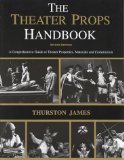
Perhaps no other book about theater props is as well known as The Theatre Props Handbook, by Thurston James.
The largest shortcoming of this book is that it was written in 1987. The World Wide Web hadn’t even been invented yet. The number of materials and tools which have been introduced since then is vast. The book has almost no safety information; the photographs show artisans working without gloves, respirators, dust masks or any other personal protective equipment. Many of the projects are built out of urethane foams; these days, there are much safer alternatives you can use.
This book is geared to the props person who finds him or herself having to prop a show with little to no resources. It does not deal with paperwork, reading a script, managing employees, shopping, sourcing, budgeting, labor estimates, or any of the other practical considerations a properties director must deal with. In a way, it’s almost a relic of a time when a props person must create every prop out of paper-mâché, epoxy putty, and hot glue.
Perhaps the other greatest downfall of the book is the organization and presentation. The chapters are apparently in alphabetical order, though what information is present in each chapter is a surprise. The photographs are all in black and white, small, and occasionally questionable. Looking at a few projects in the book, I find myself thinking that a few of the photographs are missing; he explains a step in the process, but his explanation is unclear and the inclusion of just one more photograph would suffice to make it clear.
On a personal note, my biggest pet peeve with the book is how the columns break. Each page is divided into two columns. Normally, one would think to read a column down to the bottom of the page and then start at the top of the page with the next column. In this book though, every section heading and photograph causes the columns to break, much like if you were reading a newspaper. It can be quite disconcerting.
Even though it is poorly organized, woefully out of date, and badly illustrated, there is still no viable alternative. Where this book excels is in its presentation of the tips and tricks that all props people use. If you need to learn about being a prop master, I would suggest Amy Mussman’s The Prop Master combined with Sandra Strawn’s The Properties Directors Handbook. If you want to learn how to be a props artisan, Andy Wilson’s Making Stage Props
is a more comprehensive and organized guide to the typical materials used in the construction of props. If, however, you want a source for all the props tricks used by props masters in theatre, such as putting a fake beer can label on a can of seltzer, using lamp parts, or FEV, this remains the only book you can turn to. Books like this come only once a generation or so. Perhaps props masters are unwilling to give up their secrets, or perhaps they can’t string together a coherent sentence after years of sitting through tech rehearsals. My own theory is that props people are too busy doing props to find the time to write such a book, and when they finally leave or retire, they no longer have the inclination to write such a book. So for the time being, it seems, The Theatre Props Handbook will retain its place on a props person’s bookshelf.
In some respects, the information in this book would have been better presented in blog form, if it had existed back then. I suppose that is part of my goal with this blog. I’m trying to add to and improve on the information first written down in the Theater Props Handbook twenty-three years ago in addition to writing about my own experiences.
